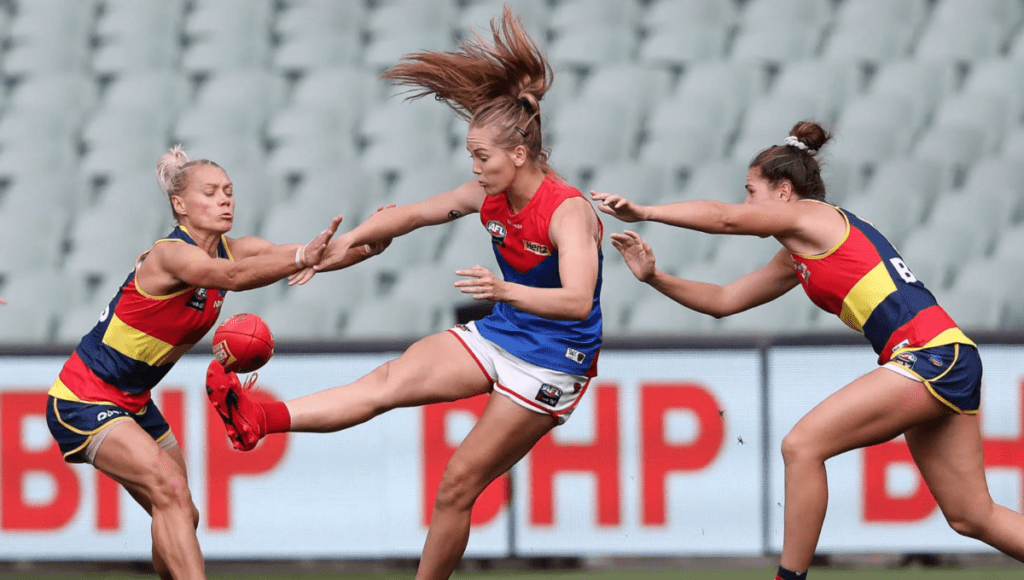Since the AFL launched its women’s league back in February 2017, the game and its players have come a long way. But the AFLW has much further to go before it is on equal footing with its men’s counterpart, and before it can truly demonstrate its value on the national sporting stage. To get there it needs – and deserves – a significant funding injection.
The 2019-2020 federal budget shows that the previous Coalition government spent around $33 million over two years to implement reforms as part of the Government Response to the Review of Australia’s Sports Integrity Arrangement (the Wood Review). Safeguarding the integrity of sport is important, of course. We know that doping, wagering, and manipulating match outcomes does much more than just tarnish the image of sport – it damages sport’s social cohesion and transformational capacities.
But the Wood Review focussed on only one of the four pillars of the (then to be developed) national sports plan – integrity. When the plan, Sport 2030, was released in 2018, it outlined the three other pillars in detail: building a more active Australia, achieving sporting excellence, and strengthening Australia’s sport industry.
Investing in the AFLW speaks to each of these pillars.
Interesting then, that the average wage for AFLW players is $46,280 a year, considerably less than the $372,00 average wage for listed male footballers in 2022. And even tier-one AFLW players are only averaging around $72,000 – when you consider that some men are exceeding the $1 million dollar mark, then integrity seems to be missing in action, at least in its broader application.
The overall improvements in crowds, revenue and player skills is taking its time. Without adequate funding from the federal government who are dishing out millions to integrity and infrastructure projects, and more money from the AFL, the AFLW will end up falling short.
Deanna Berry, Western Bulldogs AFLW midfielder, who earned a NAB Rising star award in her debut year and played in the 2018 grand final has shown in her 6-year career that women’s footy requires resilience and relentless hard work.
Berry believes that because many players have second (often, full-time jobs and work commitments) while playing footy it has a great ‘impact on the players, taking a bigger toll on the body and the hours that those girls have to do before attending training’.
Many players are forced into retaining their second jobs due to the low pay they receive. The AFL claims that AFLW players make up the majority of their income through sponsorship deals, but this isn’t the case for everyone.
Due to the training and fixture dates of the AFLW season, Berry says that one of ‘the biggest hurdles is just trying to be an elite athlete, but only doing it for a portion of the year’. Berry confirms with the change of season length and proposed fixture dates promised to align AFLW closer with the AFL season, the benefit of doing this long term means that the AFL are showing that ‘they’re moving in the right direction with having the season in August and allowing us to grow our own support base.’
AFLW players, and the game itself, are consistently being compared to the men’s AFL. But AFLW can’t keep up if players are paid less and if they’re not given sufficient time to invest in their skills and training.
Coming off the back of a pandemic, AFL news reported in February that their revenue increased by $63.3 million to $738.1 million.
The AFL then put a fraction of that into the $18.5 million in running the NAB AFL Women’s competition, the men’s side receiving $300 million.
AFL Chief Financial Officer Travis Auld says that the AFL will continue to focus on ‘…the rebuild and strengthening of the industry’. But like Berry, many AFLW players know that to strengthen the industry, you must support the players and give them what they need to undertake their jobs at an elite level.
The Western Bulldogs reported on 30 March that the federal government’s $15 million commitment to the project brings the full cost of Stage 2 works to $73.9m and complements existing support from the Club, the AFL, and the Victorian Government.
The Victorian state government has also shown a strong commitment towards the AFLW and improving all aspects of the game and well-being of players. The state government stated in January 2021 that it would commence a build on AFLW change rooms and an elite indoor training facility at Ikon Park.
The Victorian Budget 2020/21 included new allocations to upgrade or redevelop facilities for AFLW at Essendon Football Club’s Hangar ($6.28 million), Richmond Football Club’s Punt Road ($15.48 million), North Melbourne Football Club’s Arden Street ($7.28 million) and the Western Bulldogs’ Whitten Oval ($36.6 million).
With improvements being made to facilities and resources for players, the industry is heading in the right direction for future players, but time has shown that the growth of skills and quality of game play requires the inclusion of new players, but this is expensive.
AFLW skill development has been improving with each season due to new draftees coming from childhood grassroots footy. Berry says that ‘it’s so exciting watching where AFLW is going. Every season is better than the last and girls are now investing more time and effort into ensuring we are growing the standards of our game’.
‘The speed and the way the game moves now mean everyone must be fitter, faster and stronger otherwise you’ll be left behind. It’s more strategic and girls must be incredibly fit to keep up with the game.’
The AFLW is in dire need of more money, from the federal government, and the AFL themselves.
Investing into club facilities is an excellent start; it helps offer players access to elite training. And the salary increases, up from a very low average of $23,904 last year, is likewise a move in the right direction. But if the federal government is serious about its Sport 2030 plan, it needs to do more. Without providing significant financial support and efforts to develop AFLW players, they’re still going to fall short, working multiple jobs and exhausting themselves to just keep up.
The federal government might need to be reminded that the previous government was kicked out in part because of its attitude towards women.


